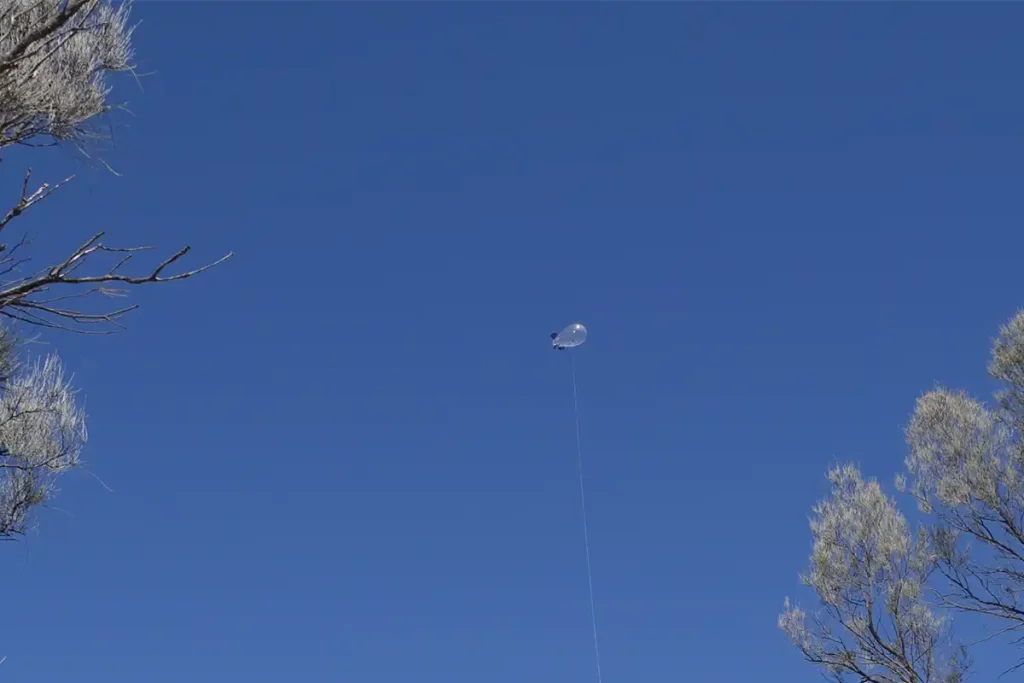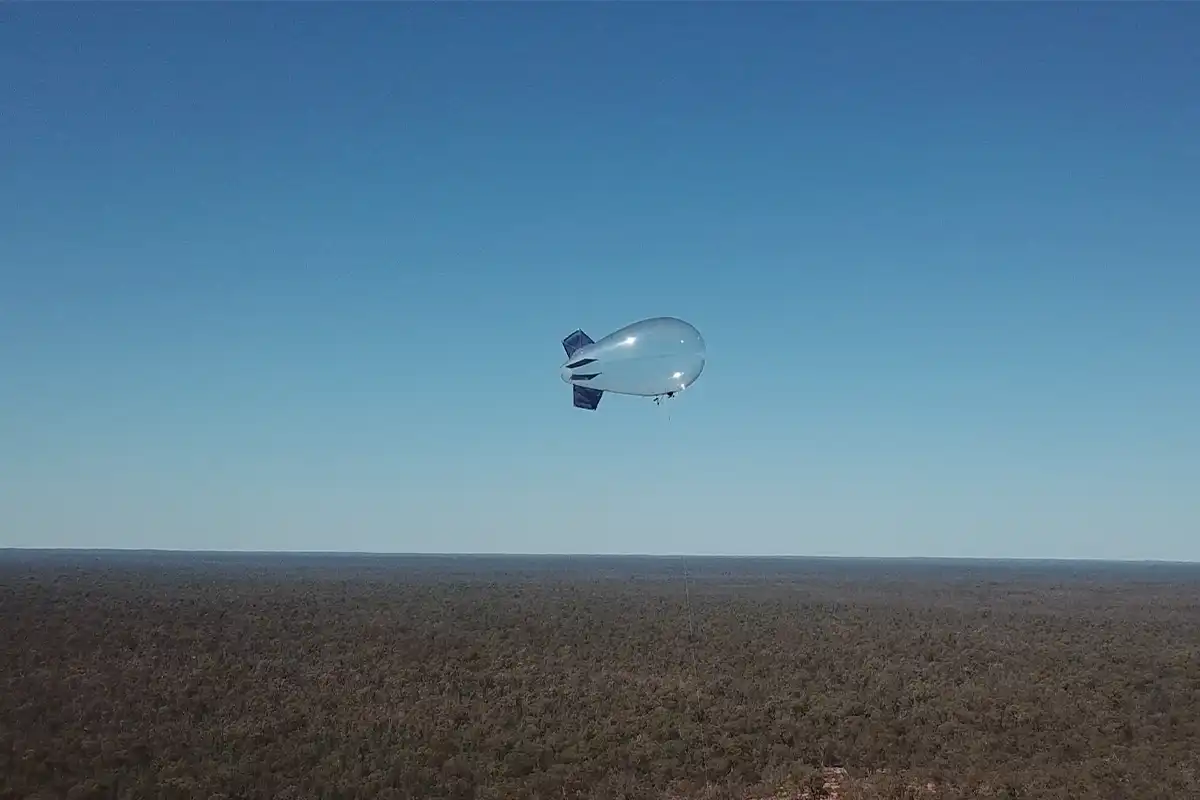The social enterprise EONEF is working towards connecting the most isolated places in the least invasive method possible: with a helium-filled balloon equipped with sensors and cameras
Introducing EONEF – developing tethered balloons
Aerial services can be useful in a number of conservation projects including tracking wildlife, monitoring air quality and detecting forest fires. The most beneficial aspect of using this type of services is how non-invasive they can be to the ecosystem around it. Up until now, the main hardware used in these projects were drones, more specifically tethered or long ranged drones. However, they all have one thing in common: the limited fly-time (depending on the size, it can last between a few minutes to about half an hour, some can stay in the air for a few hours).
EONEF is a start-up social enterprise based in France dedicated to developing and commercializing tethered balloons for projects around the world. «The balloon allows us to carry out long measurements on monitoring campaigns», explains Julie Dautel, co-founder of EONEF. «We provide a long service whereas a drone is autonomous only for a few minutes and where satellite data is expensive and doesn’t provide continuous monitoring on a specific site».
What is a tethered balloon?
At a base level, a tethered balloon is a balloon inflated with helium. It is always attached to the ground by a cable. «It can be considered as a temporarily relocated tower because it can always fly over a territory and you can relocate it according to the mission», says Dautel. The balloon itself is made from a polymer membrane to ensure that it is light enough to float with helium. They are completely reusable.
Either it gets deflated at the end of a mission or moved to another site if it is nearby. The entire lifespan of the balloon can last for years if it is taken care of properly. Their balloons are equipped with sensors, cameras and antennas which are useful in four different types of markets: air-quality monitoring, crisis-management, wildlife conservation and security and safety for private industries.
Industrializing the development of their balloons for civilian use
The latter is not the main focus for them as they are a social company and are currently industrializing the development of their balloons for civilian use. «When we first started EONEF, the purpose was to provide local and accessible post-disaster tele-communication systems with antennas. For the moment, it is the most complicated project to set up and the most difficult market to enter». Whilst they are not focusing on this market currently, Dautel mentions that there is interest in developing services for this type of monitoring.

EONEF – monitoring air quality
«Not a lot of products allow air monitoring without disturbing the environment of animals», says Dautel. «The balloon is perfect for this». Additionally, a single balloon can stay in the air for weeks, even months. This allows a type of monitoring that traditional aerial services weren’t equipped to do. With the ability to monitor the air-quality for longer periods of time, it gives researchers access to continuous data regarding pollutants in the air.
EONEF is currently working on doing this in urban areas, nearer to ports and harbors. Traditional aircrafts deployed to monitor air quality also had another limitation: for safety purposes, they were limited to how low or close they could fly to infrastructure. EONEF is in the process of deploying micro sensors to monitor pollutants and measure smoke plumes from cargo ships and other vessels found in ports. Prior to this, said monitoring was done directly from the ground or from the chimneys.
Volatile Organic Compound (VOC)
«This third dimension is a mystery» Dautel explains. Their tethered balloon can go up to 150 meters in height and withstand winds of up to sixty km/h, a quality which is useful in locations such as harbors. Depending on the type of air quality they want measured, different types of sensors can be used. How a measuring tool, such as a sensor, can measure the quality of air around us may be a hard concept to understand.
For general indoor measurements, Volatile Organic Compound (VOC) sensors are generally used. It measures ambient concentrations of gases which correlate to bad air quality including alcohols, aldehydes, ketones, organic acids, amines, organic chloramines, aliphatic and aromatic hydrocarbons.
Electrochemical cells or an infrared radiation source
The sensor picks up the data which is then sent to a lab for the measured airstream to be broken down and to ensure nothing harmful or toxic is present. In an outdoor scenario, the concept remains the same but with more complex parts to it, including electrochemical cells or an infrared radiation source. All of these get decided depending on what types of gases and/or pollutants the project wants to measure. In EONEF’s case, their sensors are equipped to not only measure the air quality but the evolution of the pollutants.
Monitoring forest fires with a tethered balloon
The balloon is ‘fragile’: it is made from lightweight materials to be able to fly. Therefore, care needs to be taken when deploying it in the field. «You can’t pilot a balloon, you can operate it», says Dautel. To get closer to certain areas, such as in the case of forest fires, smaller aerial services need to get deployed. This does not mean that the tethered balloon is not useful in these types of situations: «The balloon is good to see more land at once to detect more. After that, drones can be deployed to analyze the situation at a closer range that the balloon wouldn’t be able to», Dautel explains.
Monitoring forest fires
Additionally, small planes or helicopters usually get deployed to monitor forest fire areas. However, they can only stay in the air for a minimal amount of time and can’t examine large areas at once like a tethered balloon can. It is therefore more expensive to deploy that type of aerial service for a shorter amount of time.
Thermal imaging cameras are attached to the tethered balloon when monitoring forest fires. Dautel explains that their tethered balloons can stay up during the summer months exactly for this reason: their cameras can pick up the temperature distribution in a large area and detect hotspots.
Tracking species and wildlife in harsh terrain
An example of a project that EONEF took part in was during a wildlife expedition in Australia to monitor an endangered marsupial known as the bilby. The animals had previously been microchipped. The chips monitored their location and the tethered balloon helped to precisely determine where they were headed. The signal would cover up to 200 meters from the microchip so the balloon was useful to carry out this type of monitoring over larger vegetation patches. This type of monitoring is much less invasive than other wildlife observations: «All [the animals] do is come out, see what is happening and then go back to living their lives».
Limitations to the tethered balloon. Is it still a viable solution?
There are a few limitations to the tethered balloon. In theory, the bigger the balloon, the higher it can go because it can carry more payload and weight. The cable it is attached to is also considered towards that total. The cable limits the area that the balloon can explore. However, the exact location is measured precisely before deploying to ensure maximum efficiency in collecting data.
Other than that, the balloon itself moves within that area following the wind. Even though the balloon essentially stays in one spot, due to the height it can reach, it still covers a large area of ground. Additionally, the costs of conducting a project with the balloon is expensive. The payload, especially with the cameras, means that companies can look to pay between a few tens of thousand euros to millions. «For the civilian markets, we are trying to focus on a product that would be under 100,000 euros», says Dautel.
Repairing damaged bigger balloons
The civilian balloons would cover non-military industries, such as air quality control. Given its fragility when it comes to the material it is made from, Dautel explains that a repair kit would follow the project around. However, she points out that for larger repairs, or if one of the bigger balloons gets damaged, it needs to get sent back to the manufacturer to get fixed properly. «It’s not easy to recycle the balloon like other hardware products but when we use it, it has the lowest impact in terms of other aerial services», she says.
It is also much less invasive than any other infrastructure which could compete against it. For example, a tower; it doesn’t have any impact on the ground, it doesn’t require concrete and it doesn’t pollute the soil or air. They are currently successfully working on the industrialization of the product to enter the civilian market. «Captive balloons are on the rise and the sales are mainly in the military market for now. My job is to make them accessible to a civilian market. That is why we are trying to make them smaller and more affordable», says Dautel.
EONEF
Social enterprise which was founded in 2016 by Julie Dautel and Cédric Tomissi. They develop and commercialize tethered balloons for global projects regarding air quality monitoring, wildlife conservation and forest fire detection. They are currently working on industrializing the product to make it accessible to the civilian market.



















